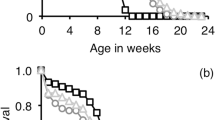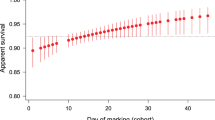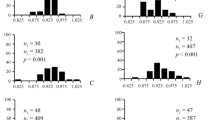Summary
Several problems were discussed in relation toMacDonald's method (MacDonald, 1957) for estimating the survival rate of a natural population of adults with varying survival rates and unstable age structure.
-
1).
Random samplings with a fixed sampling ratio and an appropriate census interval is pre-requisite during the occurrence of the adults.
-
2).
At each sampling, female adults are dissected to know the ratio,p i , of nulliparous females inith sample (i=0, 1, 2, 3, ...,). TheΣn i p i /Σn i gives an estimate of the ratio, Fα/F, of nulliparous females in the population wheren i refers to the population size onith census date. If a constant daily survival rate is assumed, the daily survival rate is estimated from equation (4′). When the survival rate is not constant over the period of adult occurrence, e. g. before and after the initiation of oviposition, the survival rate during pre-ovipositional period is estimated by equation (4″).
-
3).
Decision of an economic census interval to obtain a reliable estimate of the ratio,Fα/F, is depending on the form of emergence curve, particularly on its duration and the length of pre-ovipositional period. If the normal distribution can be assumed for the emergence curve, an interval less than one third of the emergence period is recommended. Concerning with insects having a long pre-ovipositional period, a census interval which exceeds one third of the emergence period still gives a good estimate ofFα/F.
-
4).
The mean realized fecundity of some kind of insects can be estimated by equation (5′ or 5″) using the estimates obtained by the present method.
Similar content being viewed by others
References
Itô, Y. (1963)Introduction to animal ecology. Kokin Shoin, Tokyo, Japan. (in Japanese).
Kiritani, K. (1963) Oviposition habit and effect of parental age upon the post-embryonic development in the southern green stink bug,Nezara viridula.Jap. J. Ecol. 13: 88–96.
Kiritani, K., N. Hokyo andK. Kimura (1963) Survival rate and reproductivity of the adult southern green stink bug,Nezara viridula, in the field cage.Jap. J. Appl. Ent. Zool. 7: 113–124.
MacDonald, G. (1967)The epidemiology and control of malaria. Oxford Univ. Press. London.
Utida, S. (1959) Sequential frequency of the emergence of adult insect, in relation to the change of environmental condition.Jap. J. Ecol. 9: 139–143. (in Japanese with English summary).
Author information
Authors and Affiliations
Rights and permissions
About this article
Cite this article
Hokyo, N., Kiritani, K. A method for estimating natural survival rate and mean fecundity of an adult insect population by dissecting the female reproductive organs. Res Popul Ecol 9, 130–142 (1967). https://doi.org/10.1007/BF02514920
Issue Date:
DOI: https://doi.org/10.1007/BF02514920




